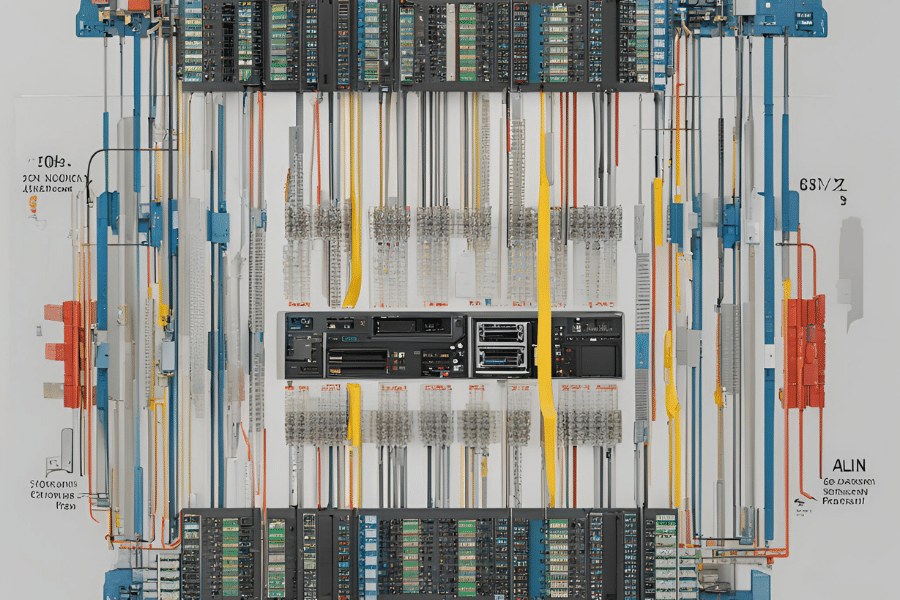VXLAN (Virtual Extensible LAN) is a technology for virtualizing networks that was invented to solve the scalability issues of VLANs (Virtual Local Area Networks). VXLAN creates an extended Layer 2 overlay network that can span large Layer 3 network infrastructures. To achieve this, it uses a 24-bit segment identifier called the VXLAN Network Identifier (VNI) that allows up to sixteen million different network segments.
VTEP or VXLAN Tunnel Endpoint is one component in the architecture of VXLAN; its job involves encapsulating and decapsulating Ethernet frames into UDP packets so they can be sent across an IP network. MAC addresses are mapped to IP addresses by VTEPs at both ends of a tunnel thus enabling transparent communication throughout the entire VXLAN fabric. This reduces broadcast traffic within a network and ensures that the underlying physical infrastructure remains unaware of any overlays on top of it.
The benefits of VXLAN become most apparent when dealing with large-scale data centers, where service provider multi-tenancy support, tenant isolation, and network segmentation are needed. By adopting VXLAN, organizations can improve their network design’s flexibility and scalability while enhancing efficiency in data center operations.
Table of Contents
ToggleWhat is VXLAN and How Does it Work?

Fundamentals of VXLAN
VXLAN creates an overlay network on top of a physical one to be more scalable and segmentable. It does this by putting layer 2 Ethernet frames into layer 3 UDP packets. The VTEPs are responsible for this encapsulation; they act as the bridge between traditional ethernet segments and VXLAN segments.
In order to differentiate between virtual networks, each VTEP assigns a unique VXLAN Network Identifier (VNI). This can accommodate up to sixteen million segments. When a packet is transmitted from a virtual machine, the VTEP will add the Ethernet frame with the VXLAN header, which contains VNI, and then send out that encapsulated packet through the IP network at Layer 3. On the receiving side, another VTEP will remove the outermost headers, such as IP and UDP, before delivering the original Layer 2 frame within a desired virtual network.
Therefore, VXLAN is essentially a method of creating many isolated virtual networks in larger data center environments where scalability and traffic optimization efficiency are needed.
How Does VXLAN Differ from Traditional VLAN?
Virtual Extensible LAN (VXLAN) is different from Virtual Local Area Network (VLAN) in many ways, with scalability, segmentation, and flexibility being the most important. Below are the main points of difference:
Scalability:
- VLAN: Supports a maximum of 4096 VLAN IDs, which may limit large data centers having extensive network segmentation requirements.
- VXLAN: It uses a 24-bit VXLAN Network Identifier (VNI) that enables scaling up to 16 million unique network segments hence greatly increasing scalability.
Encapsulation Method:
- VLAN: Works at Layer 2 (Data Link Layer) and utilizes 802.1Q tagging for encapsulation.
- VXLAN: This overlay method works at Layer 3 (Network Layer) by enclosing Layer 2 Ethernet frames within Layer 3 UDP packets. It allows more efficient traffic management across distributed data centers.
Network Topology:
- VLAN: Needs a flat Layer 2 network leading to larger broadcast domains and potential inefficiencies when deployed at scale.
- VXLAN: Establishes an overlay network that reduces broadcast traffic while providing better isolation between segments, thereby improving traffic optimization.
Multipathing Support:
- VLAN: This is usually based on spanning tree algorithms, where path utilization and network redundancy may be limited due to single path selection per VLAN.
- VXLAN: It supports Equal-Cost Multi-Path (ECMP) routing, which allows multiple optimal paths through the network infrastructure, thus enabling better load balancing and redundancy.
Tenant Isolation:
- VLAN: Provides basic isolation that is suitable for small environments but can become complicated and inefficient in large multi-tenant setups.
- VXLAN: Offers superior tenant isolation and multi-tenancy support required by modern cloud and data center environments.
These technical differences demonstrate why VXLAN is more advantageous than traditional VLANs especially in terms of scalability, segmentation and efficiency within large data centers.
Critical Components of a VXLAN Network
To understand what a VXLAN network is made of and how it works, the following components must be considered:
VXLAN Tunnel Endpoints (VTEPs):
- It is responsible for encapsulating and decapsulating packets of VXLAN traffic. It is usually found in switches, routers, or dedicated VXLAN gateways.
- What it does: It takes Layer 2 Ethernet frames, converts them into VXLAN packets, and sends them over an IP/UDP network. On the other hand, VTEP removes the packet and returns it to the Layer 2 frame.
VXLAN Segment:
- Provides logical layer 2 network segments that are isolated from each other within the same layer 3 network.
- Its Function is to create separate broadcast domains with unique VXLAN Network Identifiers (VNIs). This separation allows multiple virtual networks to work simultaneously without interference.
VXLAN Network Identifiers (VNIs):
- Is to create separate broadcast domains with unique VXLAN Network Identifiers (VNIs). This separation allows multiple virtual networks to work simultaneously
- Functions like VLAN IDs but have a much larger address space.
- How they work: They offer up to sixteen million unique identifiers for different segments which makes it possible for VLANS to scale up infinitely unlike traditional VLANs that can only handle four thousand ninety-six due to their limitation of twelve bits length
IP-Multicast or Unicast-based Flooding and Learning:
- This component deals with flooding broadcast, unknown unicast as well as multicast traffic over VXLAN network
- Operation: It either uses IP Multicast groups so that data can reach all recipients at once saving bandwidth or employs more advanced techniques such as head end replication which involve creating multiple copies of packets towards each recipient in case there are no shared networks between them
Control Plane Protocols:
- Help different VTEPs share reachability information among themselves
- What they do: Some common protocols include Border Gateway Protocol(BGP) with Ethernet VPN(EVPN) extensions designed specifically to improve control plane efficiency through route distribution along MAC/IP address dissemination.
How Does VXLAN Enhance Network Virtualization?

Benefits of Using VXLAN in Data Centers
VXLAN offers a lot of advantages for data centers which help in solving the challenges posed by current network needs:
Better Scalability:
VXLAN has the ability to scale up to 16 million logical networks that are unique as opposed to VLAN’s limited 4096 ID numbers. This makes it possible for larger-scale data centers and cloud providers who require higher levels of network segmentation.
More Network Segmentation:
With VXLAN, data centers can create different broadcast domains, which enable several virtual networks to run independently without interfering with each other. Such strong isolation enhances security and operational efficiency.
More Flexible & Efficient Traffic Management:
For efficient BUM traffic management, VXLAN allows the use of both IP multicast as well as unicast-based flooding mechanisms. Distribution of broadcast traffic is made efficient through IP multicast groups, while head-end replication, among other unicast-based methods, enhances flexibility and performance during BUM handling.
Seamless Layer 2 Networks Extension:
In terms of flexibility within data center designs, VXLAN allows extension of layer two networks over layer three infrastructure thereby providing room for more choice. This becomes very useful when it comes to moving virtual machines between different physical locations while still maintaining application continuity.
Stronger Control Plane Protocols:
Among VTEPs, routing information exchange, together with MAC address and IP address knowledge communication, is improved through VXLAN using advanced control plane protocols such as BGP with EVPN extensions. Thus, there will be efficient communication throughout the network at scale.
These benefits collectively show how much more effective, flexible, scalable and efficient VXLAN can be in data center environments thus making it a key technology for modern virtualized network infrastructure.
How VXLAN Supports Better Network Segmentation
Virtual Extensible LAN (VXLAN) is a software-defined network (SDN) technology that enhances network segmentation by overcoming the limitations of traditional VLANs. It can scale up to 16 million logical networks as compared to the 4096 VLANs, which provides scalability in large-scale data centers. VXLAN allows for the creation of virtual networks on top of a common physical infrastructure by enclosing Layer 2 frames into Layer 3 packets, thereby enabling the isolation of traffic domains without considering the layers involved. This is important for multi-tenant environments where traffic should be separated securely between clients who may share the same resources or facilities but need different levels of privacy. Moreover, it also improves efficiency through integration with BGP-EVPN, which dynamically distributes information about how different parts of the network should be segmented so that they can manage their resources well and grow easily at any time.
What is the Role of EVPN in VXLAN?

Understanding VXLAN EVPN Architecture
The VXLAN EVPN (Ethernet VPN) is a scheme that employs VXLAN (Virtual Extensible LAN) for scalable and flexible network overlays, as well as BGP (Border Gateway Protocol) control plane with EVPN extensions. In this scheme, L2 data packets are placed inside L3 packets using the VXLAN protocol. This allows creation of many networks that are separated from each other by large distances. Conversely, information on MAC addresses and IP addresses is distributed by EVPN through BGP so that layer-two connections can be made across different locations more quickly while still avoiding loops. When combined together, it ensures good connectivity within big geographical areas, thus preventing degradation in performance due to slow routing or lack of segmentation abilities during traffic isolation.
How EVPN Enhances VXLAN
The control pane of VXLAN is made more flexible by EVPN such that it scales to a large number of MAC and IP addresses across the network through BGP advertising them. Network flood is significantly reduced, which usually happens in layer 2 networks where broadcasts are required. It supports precise traffic segmentation for seamless multi-tenancy and optimal path selection through which data gets routed more efficiently with VXLAN enabled by EVPN. In addition to this, quick failover as well redundancy can be achieved thanks to EVPN’s control plane leading improved resilience and stabIn addition to this, quick failover as well as redundancy can be achieved thanks to EVPN’s control plane, leading to improved resilience and stability within networks.ty within networks. By doing so, VXLANs can be scaled up better while still performing highly secure systems integration possible between them without compromising security levels or performance standards at any time during their operation together.
Implementing VXLAN EVPN in Your Network
There are many things to do when implanting VXLAN EVPN in your network so that you have a smooth and efficient setup. The first step is to configure the core network devices for supporting BGP and EVPN. Normally this needs a firmware update as well as enabling necessary features on routers and switches. Afterward, define Virtual Network Identifiers (VNIs) for the segmentation of the network traffic where each VNI corresponds to its own isolated virtual network.
Configure BGP peerings establishment among network devices, then exchange EVPN routes which facilitate propagation of MAC addresses and IP information across all segments for efficient communication. Use control plane processes that advertise VTEPs (VXLAN Tunnel Endpoint) besides managing VXLAN overlays.
Among other things done during implementation phase include such features as route reflectors or route distinguishers which enhance scalability/ performance of networks but also monitoring frequently should be done to check if these tunnels are working well enough and BGP sessions stability too may be ensured by implementing redundancy protocols like Multichassis Link Aggregation(MC-LAG).
When following these steps, you will be able to deploy VXLAN EVPN successfully, thus creating scalable, high-speed, multi-tenant dynamic traffic segmented networks; however, always remember that continuous monitoring coupled with proactive maintenance and timely software updates are key aspects of maintaining efficiency and security within an organization’s infrastructure.
How Does VXLAN Tunnel Endpoint (VTEP) Function?

Role of VTEP in VXLAN Network
To work in a VXLAN network, a VTEP (or VXLAN Tunnel Endpoint) is used to encapsulate or decapsulate VXLAN traffic. Each VTEP adds or removes VXLAN headers from Ethernet frames so that Layer 2 networks can be extended over a Layer 3 infrastructure. Whenever an Ethernet frame enters the system, this device wraps it into a VXLAN packet and then sends it over an IP network. Upon arrival at its destination network, the recipient VTEP undoes this process by stripping off the outermost header and revealing the original Ethernet frame underneath it. Moreover, these devices keep track of routing as well as forwarding tables for Virtual Extensible LANs which ensures correct delivery of packets across such fabrics. This feature supports large multi-tiered enterprise networks because it allows them to scale up efficiently while also providing segmentation capabilities where necessary.
VTEP Configuration and Best Practices
To make sure that VXLAN Tunnel Endpoint (VTEP) is properly configured, there are several important points that must be considered regarding its performance and reliability. The first thing one should do when configuring a VTEP is to assign IP addresses correctly for each of them so that they fall under the same multicast group enabling VXLAN traffic exchange between them. Secondly, differentiate various virtual networks on a common physical infrastructure by setting up VXLAN Network Identifier (VNI). Redundancy protocols such as Multi-chassis Link Aggregation (MC-LAG) should also be implemented in order to achieve high availability and failover capability.
Another significant aspect which ought not to be overlooked while configuring VTEP is security. Use access control lists (ACLs) for traffic regulation and prevention of unauthorized entry into the network. Firmware updates should be done frequently, together with the application of security patches, so as to safeguard against vulnerabilities. Equally important are monitoring tools coupled with network analytics, which aid in detecting anomalies, thereby facilitating proactive maintenance and ensuring continuous health as well as the performance of the VXLAN network.
Eventually, it is necessary to adhere to vendor-specific best practices because such recommendations are designed specifically to optimize the performance of VTEPs within your particular networking environment. These configurations, together with the best practices, will ensure strong security measures while achieving maximum efficiency out of VXLANs.
What is VXLAN Encapsulation, and How is it Performed?

Overview of VXLAN Encapsulation Process
Virtual Extensible LAN (VXLAN) encapsulation is a way to make layer 2 networks work over a layer 3 infrastructure, using IP and multicast protocols as the basis for creating an extremely scalable network virtualization framework. It is all done by adding a VXLAN header to the primary Ethernet frame in the first step of encapsulation. A significant part of this VXLAN header is its 24-bit long VXLAN Network Identifier (VNI), which helps keep various virtual networks separate.
Then what should be described as the “original Ethernet frame along with VXLAN header” gets enclosed into a User Datagram Protocol (UDP) packet (also called datagram). UDP headers provide necessary information that allows for transportation through an IP network. Further on, we put embedded packets inside another IP packet so they are able to pass through Layer 3 networks; therefore, at any given time, these packets could be traveling across different subnets. VXLAN-encapsulated packets are sent out to appropriate VTEPs using either multicast or unicast method which ensures smooth communication between distributed network segments.
By putting layer 2 frames within layer 3 packets, VXLAN achieves excellent scalability that enables creation of large-scale flexible and efficient data center networks. Moreover, this type of encapsulation supports interworking with already existent network infrastructure thus maximizing opportunities for optimizing and expanding networks.
Decapsulating VXLAN Packets
Decapsulation is a process where VXLAN packets are converted back into their initial Ethernet frames. This is done by the VXLAN Tunnel Endpoint (VTEP) that receives them. When received, VTEP removes IP and UDP headers, which unhide the VXLAN header beneath them. The next step involves the extraction and processing of this header by VTEPs so as to get the original Ethernet frame with its associated VXLAN Network Identifier (VNI). Then, depending on VNI, the frame should be sent to the appropriate Layer 2 network segment. Through doing so, underlay networks remain transparently connected with overlays while ensuring data integrity and efficiency during transmission are upheld. Eventually, it supports smoothness in connectivity together with scalability within current data centres, thereby allowing effective network virtualization as well as management.
Layer 2 and Layer 3 Considerations in VXLAN
To guarantee the best possible performance and compatibility within the network infrastructure, it is important to take into account layer 2 and layer 3 considerations when implementing VXLAN (Virtual Extensible LAN). At layer 2, VXLAN allows Ethernet segments to be extended across logical networks over an IP network infrastructure; this includes putting layer 2 frames in VXLAN headers so that they can seamlessly traverse through layer 3 boundaries. Bridging layer 2 over layer 3 networks provides great flexibility and scalability hence making VXLAN a good solution for current data centers.
Layer three of VXLAN relies on IP-based routing for transmitting encapsulated packets between different VXLAN Tunnel End Points (VTEPs). In this design, multicast as well as unicast modes are supported, which aid in the efficient management of network traffic. Additionally, at level three, it is necessary to configure the underlying IP network infrastructure that supports overlay networking while enabling inter-VLAN routing without any hitches. Proper alignment as well as configuration of OSPF or BGP, which are IP routing protocols, will greatly contribute towards maintaining stability in the network plus optimizing the flow of data across VXLAN fabric.
All in all, successful implementation of vxlan requires careful planning regarding interactions between layers two and three. Addressing these areas guarantees the robustness and scalability of virtual networks created by this technology, thereby meeting requirements posed by contemporary enterprise setups.
Frequently Asked Questions (FAQs)

Q: What is VXLAN, and how does it work?
A: VXLAN, or Virtual Extensible LAN, is a network virtualization technology that was created to solve the problems with VLANs when used in huge data centers. To do this, VXLAN encapsulates Layer 2 Ethernet frames into Layer 3 IP packets so that Layer 2 overlay networks can be built on top of Layer 3 networks.
Q: What are the critical components of a VXLAN?
A: The main parts of a VXLAN are the VTEP (VXLAN Tunnel End Point), VNI (VXLAN Network Identifier), IP network, and encapsulation/decapsulation. A VTEP adds or removes VXLAN headers; VNIs identify separate VXLAN segments within an overlay network.
Q: How does VXLAN handle network segmentation?
A: To differentiate between different VXLAN segments, each one is assigned its own unique identifier, known as a VXLAN Network Identifier (VNI). This allows for the creation of individual virtual networks that can be isolated from one another within the data center. Up to 16 million distinct segments can be supported because VNIs replace conventional 12-bit VLAN IDs.
Q: What advantages does VXLAN offer over traditional VLANs?
A: VXLAN offers many benefits that exceed those provided by traditional VLANs, such as scalability, which supports up to sixteen million segments; flexibility, where layer two networks can be extended over layer three IP networks; and improved utilization of physical network infrastructure through leveraging existing IP-based routing protocols.
Q: How does VXLAN encapsulate and decapsulate Ethernet frames?
A: It puts an Ethernet frame into an IP packet by adding a header called “VXLAN.” This step is often referred to as ‘encapsulation.’ After that, the newly created packet can traverse any IP network. When it reaches the destination VTEP, the VXLAN header is removed, and the original Ethernet frame is decapsulated and then forwarded within the Layer 2 network.
Q: What does the VXLAN Gateway do?
A: The VXLAN gateway acts as a bridge between traditional L2 networks and the VXLAN overlay network. It encapsulates and decapsulates Ethernet frames necessary for devices within VXLAN to communicate with those on ordinary VLANs.
Q: How is VTEP used in VXLAN environments?
A: A VXLAN Tunnel End Point (VTEP) is a device, usually a physical switch or virtual machine, that performs VXLAN encapsulation and decapsulation. VTEPs add VXLAN headers to Ethernet frames before sending them across IP networks, then remove these headers when receiving them so that original frames can be restored.
Q: Is it possible to support VXLAN in existing network infrastructures?
A: Yes, you can support vxlan within existing network infrastructures that are capable of handling IP networks and routing. For example, Juniper Networks US, among others, supports vxlan on many modern switches, which makes it possible to integrate vxlan into established data center networks without doing a complete overhaul.
Q: What are some common use cases for VXLAN?
A: Common use cases for vxlan include extending layer 2 networks over layer 3 infrastructures, enhancing network segmentation in multi-tenant environments, enabling virtual machine mobility across data centers, and improving scalability in large network fabrics. It can be especially useful in modern virtualized data center networks where traditional VLANs are restricted by scope and flexibility.
Q: In relation to VXLAN, what does RFC 7348 signify?
A: RFC 7348 is the official specification for defining vxlan. It contains detailed information about the protocol, such as encapsulation format, control plane mechanisms, and operational guidelines, among others, that should be followed when implementing it as part of one’s network design or architecture. This document serves as a foundation for understanding how vxlan works within different environments
